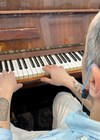Glue ear is a very common problem in children. This article explores a simple and affordable solution to help overcome some of the challenges it can cause.
Background
Glue ear (also known as otitis media with effusion – OME) is a common, fluctuating and recurring problem. Conductive hearing loss in childhood remains problematic across the globe as glue ear in the global north affects around one in 10 children starting school, and chronic suppurative otitis media in the global south tends to be seen more where healthcare is less accessible and poorer nutrition or exposure to smoke (such as cooking smoke) is more prevalent [1].
Of course, mild or moderate fluctuating hearing losses are invisible but can impact speech, communication, reading, anxiety, confidence and learning. We risk children’s development by not providing early interventions or maintaining speech and language enrichment. As usual, children in poverty, or with existing educational difficulties, or those in complex families with existing challenges, are impacted the most, maintaining health and educational inequalities across generations.
Hear Glue Ear bone conduction (BC) headsets
Hear Glue Ear is a non-profit project aiming to provide very simple, affordable, bone conduction hearing to children, so that early hearing intervention is possible. In the UK, this can be used while children wait for a more bespoke intervention such as hearing aids or grommet operation. The bone conduction headsets were trialled in the UK during the Covid pandemic as a simple assistive technology that could be sent by post to enable families to self-manage their child’s glue ear [2]. It was also trialled in the global south where children or adults can’t reach or afford audiology or hospital services. [3]
Since a set of bone conduction (BC) headphones can be used by anyone, (especially good for those who want to listen to music while running, cycling, walking, etc., ensuring their ears are ‘open’ to traffic and other environmental sounds) it is CE marked as such and, because of its universality, the MHRA (Medical Health Regulation Authority) confirmed the product is an assistive technology rather than a medical device. The microphone that can be found in the accessories box is there if needed so that a speaker (such as a teacher, speech and language, therapist or parent) can be heard more clearly by the person wearing the headset.

A child with conductive loss wearing the bone conduction headset.

The Hear Glue Ear headset, accessory microphone and Hear Glue Ear app.
The BC headset can also be connected via Bluetooth to a computer, phone or iPad/tablet for listening to audiobooks, films and the Hear Glue Ear app. Children find ingenious and bespoke ways to connect their BC headset to the TV, Alexa or gaming devices, which also tends to support further speech and language enrichment.
Hear Glue Ear app
The Hear Glue Ear app aims to provide a solution and has been free due to charity partnerships with Cambridge Hearing Trust (CHT) and the National Deaf Children’s Society (NDCS) since 2018. The Hear Glue Ear app is used widely across the UK for children aged two to eight years who have been diagnosed with glue ear. It provides information for parents, free speech and language therapy advice, free audiobooks, listening games and a home hearing game (in either a tone test or a speech discrimination test) to help parents estimate their child’s hearing fluctuations. The family can use the Hear Glue Ear app on any device (it can be downloaded on Apple or Android app stores) with or without a bone conduction headset. Similarly, the headset can be used without the app. It is hoped this prevents health inequalities as much as possible from digital or financial exclusion.
Reducing stigma
Assistive technologies in hearing have been prioritised by the World Health Organisation (WHO) since over 80% of hearing needs are unmet, and unaddressed hearing loss costs the global economy around one trillion US dollars annually [1]. Improving hearing improves access to education and employment. Stigmatising mindsets have prevented hearing loss being addressed for generations and in multiple countries, which is why there is a joy in the headsets availablity for people without or with hearing loss. Since the BC headphones can be worn by anybody, no one is singled out for wearing the technology and we have had reports of young children who use the headsets for glue ear asking adults using BC headphones for fitness how their hearing is! It is hoped that by dissolving the stigma around hearing technology, more hearing loss can be self-managed by families, especially those on long waiting lists. One child who referred to her bone conduction headset as her ‘extendable ear’ – a reference from Harry Potter – helped author a publication in the BMJ (British Medical Journal) to reduce stigma further [4].
Affordability
Keeping the product affordable and accessible has been incredibly challenging but, due to charity partnerships and extraordinary kindness from multiple individuals with purpose above profit, the product is available on thepihut.com. Raspberry Pi have placed headsets and microphone kits on their shelves at the lowest price possible, as well as enabling work in low-income countries.
Research
Research has shown that about half of children at primary school will choose to take a bone conduction headset into school [2,5]. The Hear Glue Ear app has a home-school care plan to enable families to share information about their child’s glue ear with school to best enable access to the curriculum. We can’t forget that hearing loss has an impact on social, emotional and psychological wellbeing, with some children developing anxieties about social situations or being told off at school.
Empowering self-management
Hearing health has a far wider impact than clinicians can address in one clinic appointment. With expanding waiting lists, growing levels of childhood poverty and less access to healthcare professionals in almost every country, health services need to empower families to self-manage their child’s glue ear to prevent long-term sequelae and improve quality of life. Glue ear is a fluctuating condition, if families can self-manage once, they can also manage recurrent episodes, while waiting to see a healthcare professional or waiting for self-resolution. In turn, this could reduce waiting lists and allow healthcare professionals time to see the patients who need to be prioritised.
Auditory processing
Of course, there is a possibility that affordable BC headsets could be suitable classroom devices for those with auditory processing difficulties or disorders (APD) [5]. Further research would be welcomed in conditions such as APD and attention deficit disorders.
Further Information
-
To find out more see website:
www.hearglueear.co.uk
-
To purchase a headset visit:
https://thepihut.com/products/
hear-glue-ear-headset-microphone-kit -
Instructions for use:
https://static1.squarespace.com/static/
624f1012efc11c5648a6f97b/t/65c7d58
a63bc2439a487cac4/1707595151506/
Instructions+for+headset.pdf) -
To understand more about the Hear Glue Ear app see:
www.hearglueearapp.com
References
1. Holland Brown T, Chadha S. Ear and hearing health in children. Paediatrics and Child Health 2024;1751-7222.
2. Holland Brown TM, Fitzgerald O’Connor I, Bewick J, et al. Bone conduction hearing kit for children with glue ear. BMJ Innovations 2021;7:600–3.
3. Bene M, Phiri M, Fitzgerald Oconnor I, et al. Trial of Affordable Bone Conduction Headphones to Support a Deaf Child’s Education in Malawi. J Patient Ex 2023;10.
4. O’Riordan D, Holland Brown TM. Harry Potter’s extendable ear: reaching deaf children. BMJ Arch Dis Child 2024 (Online ahead of print).
5. Holland Brown T, Marriage J, Salorio-Corbetto M. Speech discrimination and word identification with a consumer-level bone-conduction headset and remote microphone for children with normal hearing. Int J Audiol 2023;62(4):320–7.
Declaration of competing interests: THB conceptualised the use of bone conduction headphones and was the creator of Hear Glue Ear app. She has not benefitted financially from this project. Her research is used in the creation of the article.









